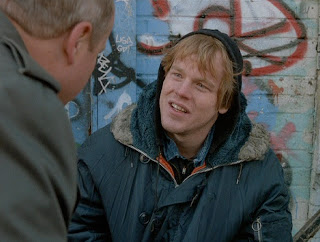For five years or so, when I lived on the Lower East Side, Philip Seymour Hoffman and I saw each other weekly, sometimes daily. We never met; we just wandered the same everyday paths so consistently that I felt that we knew each other. He shuffled, carried a frumpy bag, and frenetically affected invisibility. With a different gate, and different accoutrement, I always hoped no one would see me in the way I imagined, based on his patterns and mannerisms, that Hoffman hoped no one would see him. Given that Hoffman was not yet so widely known, and that we both could manage a fair job of projected invisibility, I suspect that we each moved through our respective days predominantly unseen. Thus, crossing paths with Hoffman, and recognizing myself in what I imagined of him, made me feel at home, somehow simultaneously safely unseen and profoundly seen. Although I moved on and Hoffman took off, and our regular crossings ended, his performances have never failed to conjure up this feeling of comfort layered onto the fundamental discomfort I felt and still often feel in the world. Even when I have not cared for his choice of movies–a question of my own taste and not his extraordinary performances–I have gone to see them in order to be comforted by my old friend.
Friend is a strange word to use for someone one has never been introduced to, but the intimacy of repeated encounter on the terms that I experienced with this particular stranger catalyzed feelings for which I have no word but friendship. Connection, or even imagination, might be terms more apt, but I prefer friendship for its implication of warmth, an implication that his image on screen continued to conjure throughout his career as photographs of long lost friends might do. Though his roles varied dramatically, I never failed to intuit the East Village guy, whose actual name I always knew—he was known enough in the indie circles I traveled—but whom I recognized not for his professional life but as a familiar, someone who like me did not seem to need introductions at all because they would not change what was already known. For these reasons, I appreciate Tom Junod’s obit-tribute in Esquire more than any others. Junod gets at something vital about Hoffman’s gift to his audiences that most other tributes I’ve read do not seem to understand.
These reasons are also why I appreciate some art and some literature and the three critters with whom I live and travel. I experience with them relationships that, for lack of a better word, I term friendships. They, of course, defy most contemporary definitions of relationship, never mind conceptions of friendship. They do not necessarily involve introductions. They cross species and even forms of matter. Nonetheless, they are some of my most significant and enduring relationships, and these kinds of friendships have always characterized my world.
When I was four years old and living in Los Angeles, my mother took me to LACMA to see the Calder mobiles and the La Brea Tar Pits for the first time. As two of my earliest friends, together and separately, they map my world. Alexander Calder’s enormous mobiles cut space into process rather than product. This feat acknowledged space and time as an integrated continuum. Bright colors moving through space seemed to offer more accuracy than a watch for knowing when and a map for knowing where by conflating when and where across the two as one action rather than two points. The tar pits confirmed the concept by illustrating the continuum. Bubbling up from their smelly depths came truths that the mobiles marked. Their common language relied on a mutual understanding of scale. This scale was not human, but at four, it made infinite sense to me, not unlike when two decades later, my friendship with Hoffman made sense. In unlikely but analogous ways, Hoffman, Calder, and the La Brea tar pits became my friends because I could recognize myself in them, and this made me feel a part of things. These friendships ameliorated alienation.
I have a new friend in Warsaw: the sculptures and drawings of Polish artist, Honza Zamojski. Like the other friends I’ve mentioned in this piece, Zamojski and I have not met. In fact, I have resisted the impulse to meet even when an introduction would have been easy. My friendship is not with Zamojski the person but with my ideas about and encounters with his work, with the ways in which it has shown up as signposts since my arrival in Warsaw last August. Via serendipitous encounter during Warsaw Gallery Weekend 2013, “Fishing with John” has woven itself into my current work; via unwitting allusion, it’s been woven retroactively into an essay that appeared in the Mid-American Review in 2006 called, “How to Hunt & Gather;” and this week, my connection to these pieces ties me back to my old stomping grounds in NYC, where they are currently installed.
These maneuvers are what friendship does. It weaves primarily unrelated phenomena into something familiar and warm that engenders a sense of belonging. It is not an objective process, but a highly subjective phenomenon. My old friend from the Village affirmed my own existence each week when our everyday coincided. He reminded me of this every time I saw him on screen. In death, he causes me to understand how and, moreover, to appreciate–profoundly–friendship, in all its myriad forms.
***
New Yorkers, and those inclined to hop on over for a visit: I encourage you to meet my new friends between now and February 15. Check out Honza Zamojski’s “Self Portrait with Fish,” installed at Andrew Kreps Gallery in Chelsea.
Photo Source: Source: Studios USA Television, NBC Universal Television, Universal Network Television (Hoffman on Law & Order, Season 1, Episode 14, 1991)

